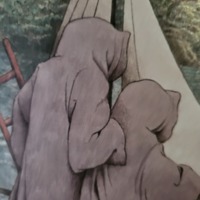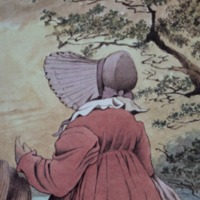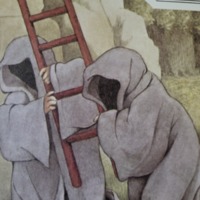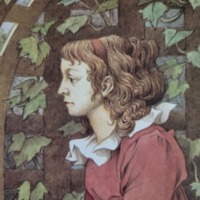How the book works and why the book matters
"Outside Over There brought some hostility from children, but it was a book that made them chew. It works...[but] You've gotta make it work" (Sendak interview 2003).
See Why Outside Over There? for an overview and summary of this story.
Sendak has described Outside Over There as part of a trilogy following Where the Wild Things Are (1963) and In the Night Kitchen (1970). Each of the three books explore "how children master various feelings--anger, boredom, fear, frustration, jealousy--and manage to come to grips with the realities of their lives" (Sendak qtd. in DeLuca 7).
Children and Adults
The text in Outside Over There is sparse and vague. For instance, it says that “Mama [is] in the arbor” (8) but offers no explanation beyond this. This minimal text reflects the confusion that Ida may feel regarding her parents’ absence. In contrast, the illustrations are intricate and layered with meaning; they express Ida's feelings toward the world.
One instance of this is the depiction of a large and heavy baby. On page 8, while Mama appears catatonic, Ida holds her crying baby sister. The baby is so big that she slips from Ida’s arms, emphasizing the heaviness that Ida feels and her resentment in having to care for her sister while Mama ignores them.
One of the reasons why adults challenge this story is that the parents seem useless and oblivious to the children’s danger. However, that is exactly Sendak’s point.
In the first few pages, Mama shares similarities with the goblins. The saturated red of her dress matches their ladder, and her bonnet matches their cloaks. On both pages 6-7 and 8-9 (left) Mama and the goblins are on the edges of opposite pages, mirroring each other.
Gregory Maguire notes that the goblin characters act as a type rather than as individuals (110-111): they represent danger, resentment, and perhaps depression. Interestingly, the text does not mention the goblins on these pages. This visual counterpoint adds complexity to Mama’s character. Her likeness to the goblins may suggest that her behavior resembles their own, or it may express Ida's feelings, symbolized by the goblins and reflected in Mama.
On pages 8-9, Mama is actually looking directly at the goblins, although she shows no sign of recognition.
From Ida’s perspective, Mama is absent and failing to protect her children.
Experiences of Parental Absence
Parental absence is a pervasive issue in society. In a 2018 survey, the Canadian Child Welfare Research Portal found that 21% of investigated reports of maltreatment to children was caused by neglect. A 2023 survey from the U.S. found that 78% of cases involving maltreated children stem from issues of neglect. This number is probably much higher since neglect and absence may often be felt but not seen.
Through depicting negligent and absent parents, Outside Over There acts as what Rudine Sims Bishop calls a "mirror," meaning that it reflects children's lived experiences back to them; it also acts as a "window" through showing other readers a different life experience ("The Enduring Impact of Rudine Sims Bishop" 67).
Readers who face alienation and neglect may take inspiration from Ida's brave determination, while other readers may better understand the challenges that many children experience and that many adults grew up experiencing. Here it must be recalled that Sendak wanted this book to be read by adults and children: neglect, loneliness, even fear of abduction, or losing a loved one are timeless and universal concerns.
The story also alludes to the historic Lindbergh kidnapping, a case that challenged assumptions about how well we can protect children.
The Lindbergh Baby
In 1932, twenty month old Charles Augustus Lindbergh Jr. was kidnapped from his nursery. According to the FBI, “traces of mud were found on the floor of the nursery. Footprints...were found under the nursery window. Two sections of the ladder had been used in reaching the window…”. Just over two months later, the baby’s dead body was found.
You can read about the details of this case on the FBI's website.
Maurice Sendak was four years old when this kidnapping appeared in the news, and it deeply disturbed him for the rest of his life. While not explicitly about this, Outside Over There uses similar details from the original case: goblins take the baby from her crib, and they use a ladder to get inside. This also alludes to the issue of dichotomizing inside and outside.
Inside and Outside: The Illusion of Safety
Elizabeth Marshall notes that concerns over what picturebooks are acceptable for children often “ignore the varied material experiences of children, and usually attempt to collapse all childhoods into a coherent and idyllic version of innocence” (160).
Children are bombarded by disturbing news stories and lewd advertising, yet many parents seem to overlook this when they challenge books that feature dark content. Prohibiting certain books may give parents a sense of control over what their child is exposed to but, as Outside demonstrates, with allusions to the Lindbergh case, it is simply impossible to keep everything dangerous out. Instead, children need to learn how to respond to danger and darkness when it arises.
Scary and unsettling picturebooks provide children with a space to think through and discuss problems that they already face. As Janet Evans puts it, "Picturebooks can help children relate to, and come to terms with, troubling, disturbing and sometimes controversial issues in life" (6). In fact, Evans goes so far as to say that we do a grievous disservice to children when we deprive them of uncomfortable stories.
Outside Over There shows the permeability between inside and outside. Inside the house, a place that often symbolizes safety, danger can still enter in.
Moreover, sometimes safety can be achieved only by going outside, towards the danger, and facing it.
Character
"Ida...is pluckier than any Sendak hero or heroine to date. [Sendak] is full of admiration for Ida's courage and ability to take action despite her own fears and her jealousy of her lost sibling" (Lanes and Morton 232).
Outside speaks to real-world issues, yet instead of decrying the injustices children experience, it empowers children to face and triumph over their challenges.
Ida makes several mistakes, but she perseveres and overcomes the darkness that she faces. This is evident from the text.
At first, Ida is:
- A reluctant babysitter who "never watched" (10), and according to Sendak, jealous and resentful towards her baby sister (Gottlieb 211)
- She begins her journey by making "a serious mistake" (17)
- The narrator calls her "Foolish" (20)
It is only when she hears the words of her Papa and "turn[s] around again" (23) that things begin to change:
- When Ida reaches the goblins, she becomes "sly" and uses her horn to charm them (26)
- The goblins call Ida "terrible" (28) while she enchants them so that she can retrieve her sister.
- Papa's letter describes her as "my brave, bright little Ida" and instructs her to continue to "watch the baby and her Mama" (38).
This character change is enhanced through the illustrations.
"She climbed backwards out her window into outside over there" (8-9).
Ida's venture into the dangerous outside is depicted on pages 8-9. The text here is vague and leaves multiple gaps, including exactly what it means to climb "backwards" out a window. Furthermore, the words "outside over there" offer no explanation of where exactly Ida is going.
The left side of the spread shows the goblin ship and the goblins carrying Ida's sister over a bridge. One of the goblins carries a ladder and another carries an umbrella. In the distance, beyond the mouth of a cave, a full moon is just visible amidst stormy clouds. A crack of lightning nearly touches stony stairs that lead down into the river.
Both the ship and bridge are too small in proportion to the characters. This surrealist size distortion suggests that Ida is moving into a dreamscape.
Molly Bang argues that geometric shapes can be used to evoke specific emotional responses (xiii). Here, the ship and bridge create a slightly diagonal line that points toward Ida on the right page, while the ship's mast and the goblin's umbrella point vertically upward and the ladder points on a diagonal. The arches between the bridge's piers, the stormy sky, and what appears to be the mouth of a cave create half circles. According to Bang, irregularlity and a lack of consistent pattern can be used to evoke a sense of fear and confusion (98).
In comparison to the left page, the setting on the right page shows a straight and orderly window from which Ida is exiting. Ida must leave the safe and predictable world behind, in order to face danger and rescue her sister.
With her limbs stretched out in front, Ida's body creates an upside-down triangular shape, implying uncertainty. This also clarifies the cryptic text which simply says that she “climbed backwards.” Ida’s backwards climb seems more akin to falling and it suggests that she lacks full agency.
The directionality is also significant. Because we tend to read from left to right, we associate figures moving right as progressing forward and figures moving left as moving backwards, or towards home (Nodelman 96; 115).
Seen this way, Ida is moving in the wrong direction to rescue her sister. She is also wearing Mama’s yellow rain cloak which, oversized and draping, obscures her to the point that she resembles a goblin more than a person.
Ida’s choice to wear her Mama’s cloak seems to disorient her. It is after Ida puts the cloak on that she leaves the house backwards and only when she turns around and the cloak begins to fall off does she move in the right direction. As she reaches the goblins, Ida's cloak continues to fall off. On page 20, a victorious Ida casts the cloak off completely as she plays her "frenzied jig" to enchant the goblins away.
When Ida returns home, she leaves the cloak behind.
Image below: click to view in fullscreen and then click on the coloured buttons and lines to learn more about the power of this illustration from Outside Over There.
Spread taken from pages 8-9.
Transformative?
Book bans and challenges are becoming increasingly prevalent in the U.S. and Canada. While Outside does not fall within the most current commonly challenged categories, it touches on the underlying concerns that prompt book banning in the first place: fear of what seems strange and scary.
However, scary stories can teach children (and adults) not to run away from fears they experience. It is only through facing fears that we discover whether the fear ever had any substance, or whether it was a baby in the guise of a goblin all along. Stories like Outside Over There teach readers that darkness can be faced and can be overcome.
At the same time, the illustrations offer a window for adults into a child’s world, full of complexities and fears. It reminds adults that children’s worlds are not as safe and innocent as we often pretend that they are.
Outside Over There should be included in a children’s literature course because it addresses important root causes of book banning and empowers readers to take action against their own fears, rather than running away, or “banning” what we do not like. This is a book about surviving and it is as applicable to adults as well as to children: it forces readers to become uncomfortable but it ultimately leaves them with agency and dignity to face the world.
Further Resources
- Book: The Art of Maurice Sendak by Selma Lanes and Robert Morton explores Sendak's life and the influences on his art and writing. It includes sections specifically about Outside Over There and touches on the bizarre elements, including the influence Mozart's music had on the story.
- "A Good Book About Hard Things" (see below) a book review of Outside Over There by The Picture Book Library
Sources
“A Good Book About Hard Things: BOOK REVIEW: Outside Over There by Maurice Sendak.” YouTube, uploaded by The Picture Book Library, 16 Feb. 2021, https://youtu.be/EyJNbJWHJfA?si=utwIVBjdz2d0AmGc.
Bang, Molly. Picture This: How Pictures Work. San Francisco, Chronicle Books, 2016.
Brown, Casey L., Musa Yilanli, and Angela L. Rabbitt. “Child Physical Abuse and Neglect.” National Library of Medicine. 29 May 2023. https://www.ncbi.nlm.nih.gov/books/NBK470337/. Accessed 2 Aug. 2024.
"Censorship by the Numbers." American Library Association, 20 April 2023. https://www.freedomtoread.ca/articles/rising-tide-of-censorship-recent-challenges-in-canadian-libraries/. Accessed 4 Aug. 2024.
DeLuca, Geraldine. “Exploring the Levels of Childhood: The Allegorical Sensibility of Maurice Sendak.” Children’s Literature, vol. 12, 1984, pp. 3-24. doi.org/10.1353/chl.0.0260.
Evans, Janet. "Picturebooks as Strange, Challenging and Controversial Texts." Challenging and Controversial Picturebooks. Edited by Janet Evans. London, Routledge, 2015. Pp. 3-32.
Fassler, Joe. “Maurice Sendak Scared Children Because He Loved Them.” The Atlantic, 9 May 2012. https://www.theatlantic.com/entertainment/archive/2012/05/maurice-sendak-scared-children-because-he-loved-them/256928/. Accessed 22 July 2024.
“History: Famous Cases and Criminals | Lindberg Kidnapping.” FBI. https://www.fbi.gov/history/famous-cases/lindbergh-kidnapping. Accessed 22 July 2024.
Lanes, Selma G., and Robert Morton. The Art of Maurice Sendak. Abrams, 1980.
Gottlieb, Richard M. “Maurice Sendak’s Trilogy.” The Psychoanalytic Study of the Child, vol. 63, no. 1, 2008. Pp. 186-217.
Maguire, Gregory. Making Mischief: A Maurice Sendak Appreciation. 1st ed., William Morrow, 2009.
Marshall, Elizabeth. “Fear and Strangeness in Picturebooks: Fractured fairy tales, graphic knowledge, and teachers’ concerns.” Challenging and Controversial Picturebooks. London, Routledge, 2015. Pp. 160-177. https://doi.org/10.4324/9781315756912.
Nodelman, Perry. Words about Pictures: Narrative Art of Children's Picture Books. University of Georgia Press, 1990.
Nyby, Michael. "A Rising Tide of Censorship: Recent Challenges in Canadian Libraries." Freedom to Read, 2024. https://www.freedomtoread.ca/articles/rising-tide-of-censorship-recent-challenges-in-canadian-libraries/. Accessed 4 Aug. 2024.
“Ontario – Statistics.” Canadian Child Welfare Research Portal. https://cwrp.ca/ontario-statistics. Accessed 1 Aug. 2024.
Sendak, Maurice. Outside Over There. New York, Harper Collins, 1981.
---. “Picture Book Genesis: A Conversation with Maurice Sendak.” Children’s Literature Association Quarterly, no. 1, 1978, pp. 29–40, https://doi.org/10.1353/chq.1978.0005.
Sutton, Roger. “An Interview with Maurice Sendak.” 1 Dec. 2003. The Horn Book. https://www.hbook.com/story/an-interview-with-maurice-sendak. Accessed 31 July 2024.




